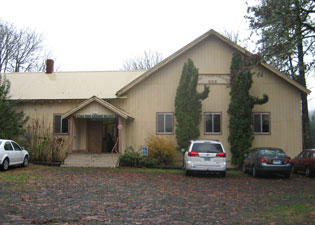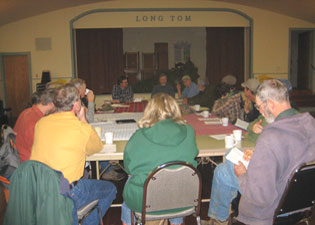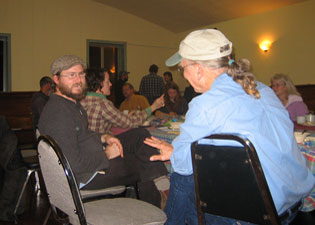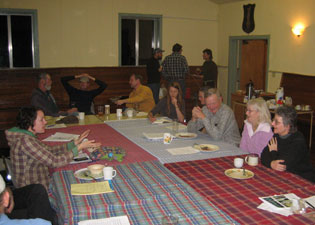

Home | Spaceship Earth | Book Reviews | Buy a Book | Bean and Grain Index | Short Stories | Contact | Mud Blog
By Dan Armstrong
The Southern Willamette Valley Bean and Grain Project hosted its sixth winter farmers meeting at the Long Tom Grange outside Junction City, Oregon on Tuesday, December 4, 2012. Approximately thirty people, almost entirely farmers, were in attendance for a roundtable discussion with Jim Myers, a horticulturist from Oregon State University.
The winter farmer meetings are meant to be educational forums on agricultural topics specific to growing, processing, and distributing beans and grains in the Willamette Valley. The format is a roundtable discussion, followed by a social hour and pot luck dinner. Last winter Steve Jones from the Washington State University Extension Center in Mount Vernon, Washington joined in the discussion on growing wheat in the Pacific Northwest. This year, we were fortunate to have Jim Myers of OSU take part in our roundtable on dry beans.
Who is Jim Myers?: Jim Myers is a professor of vegetable breeding and genetics in the Horticulture Department at Oregon State University. His work focuses on the development of vegetable varieties suited for the Pacific Northwest, with special interest in breeding for disease resistance, enhanced human nutrition, and adaptation to organic production. He currently maintains breeding programs in snap peas, yellow beans, broccoli, tomatoes, and cucurbits. He has developed and released two tomato cultivars, one green bean cultivar, and thirteen dry bean cultivars, including lines of pinto, black, cranberry, and navy beans. Jim is also the Project Director for the Northern Organic Vegetable Improvement Collaborative (NOVIC). From 1990 and 2007, Jim worked with the Bean/Cowpea CRSP to develop dry bean cultivars for Eastern and Southern Africa. In 1999, he received the Bean Improvement Cooperative Distinguished Achievement Award.
In Attendance: The meeting was attended by farmers from Sunbow Farm, Open Oak Farm, Lonesome Whistle Farm, Diamond Hill Farm, Greenhill Farm, Hands on Organics, Circle H Farm, Horseshoe Lake Farm, Slippery Slope Farm, and Hunton Family Farm. Food for Lane County and Hummingbird Wholesale were represented as were the Project's two non-profit support groups, Willamette Farm and Food and Ten Rivers Food Web. John Stevenson Regional Climate Extension Specialist from the Oregon Climate Change Research Institute and Dean Rae of the Capital Press were also there.
Two of the south valley's most experienced organic bean growers–Carol Deppe and Al Dong–came to the meeting. Carol lives in Corvallis and has been breeding vegetables for thirty years. She is the proprietor of Fertile Valley Seed Company and has written two gardening books, The Resilient Gardner: Food Production and Self-reliance in Uncertain Times and Breed Your Own Vegetable Varieties: The Gardner's Guide to Plant Breeding and Seed Saving. Al has been growing organic dry beans commercially in Veneta for eighteen years.


Discussion: The round table was arguably one of the most technically elevated of all the Bean and Grain Project meetings to date. Along with Jim Myers, the presence of Carol Deppe and Al Dong plus growers Andrew Still, Jeff Broadie, Kasey White, Tom Hunton, Harry MacCormack, Dick Wadsworth, Alan Adesse, and others made for a lively and free flowing conversation.
Jim Myers opened the discussion by calling the growers attention to Bean Common Mosaic Virus (BCMV). He provided a handout and spoke to the group about the related problems.
BCMV occurs all over the world and is one of the most serious bean diseases. The virus is seedborne, making it particularly troublesome to seed producers, and it is easily spread by aphids. As such growers of heirloom varieties are particularly vulnerable to infection by this virus since most heirloom varieties are susceptible.
BCMV was first observed more than 100 years ago in Russia. Visible symptoms are not always present, but traditional characteristics are a mosaic on the leaf (light and dark patches of green), leaf lesions, vein bending or leaf cupping (curled or malformed), and systemic necrosis (black root). See photos. Because many of these symptoms can be caused by other conditions, diagnosis of BCMV by symptom only is not considered reliable. BVMV is seen in black turtle beans, pinto beans, cranberry beans, Navy beans, small white beans, red kidney beans, and Red Mexican beans—to name a few that are grown in the Northwest.
Transmission by seed is the most problematic. The best way to avoid this is to use resistant seeds. If the seed is not certified resistant, a grower should obtain proof that the seed is virus free before purchase. Dispersal within and between fields can occur by aphid feeding and movement. Insecticide application to eliminate aphids is not recommended and may even cause faster spreading of the virus. Seed assays for BCMV can be obtained through the ELISA Lab at the Irrigated Agriculture Research and Extension Center at Washington State University, Prosser, Washington.
(See handout supplied by Jim Myers. The material above was sourced from the handout or Jim's comments at the meeting.)
1. The 2012 growing season was one of the best in recent years for growing beans in the Northwest. Despite another wet June, a rare rain-free September allowed for drying in the field. September 2011 was also relatively dry compared to other Septembers since the beginning of the project.
2. Combine harvesting remains a problem for dry beans. No local farms have combines specific to harvesting beans. Because of this, splitting is common. A suggestion was made that the beans, once windrowed, should be combined in the morning instead of the afternoon. Higher moisture levels due to morning dew might help prevent splitting.
3. Irrigation of the dry beans remains a debate. The lentils and garbanzos grow well and productively without water. This is accepted as fact. However, there are two schools of thought regarding the large leaf dry beans–pinto, cannellini, whipple, orca, cranberry to name a few. With deeper cultivation and generous row spacing, several varieties of large leaf beans were grown on two farms–Sunbow and Greenhill–without water and with excellent results–good yield and plump beans. In other instances where the large leaf beans were grown without water, the yield was low and the beans were smaller. There is clearly an art to this. Location is part of it, but it is possible. Most growers provide limited irrigation for their beans–three times during the season. One early if the weather demands. A second at blossom. And a third no less than three weeks from the anticipated harvest. Increased watering, however, does extend the life of the plant. In our short-season climate, the trade-off is yield versus drying in the field. With the recent dry Septembers, maybe this won't be as big a problem.
4. Several micronutrients were identified as necessary for producing the best beans: sulfur, boron, and molybdenum.
5. Nightshade was a common weed problem for the dry bean growers. Al Dong suggested using a flex-tine cultivator driven at 2 to 3 miles per hour. He recommended doing this once on the 20th of July–just before the nightshade berry develops.
6. Organic dry beans do cross readily, even across species. This is in part due to the fact that the Willamette Valley climate allows the blossoms to last longer than in dryer regions.
7. Jim Myers is working on a yellow bean from Peru. He is breeding it for disease resistance. It could be a good fit for the Willamette Valley.
8. Harry MacCormack voiced success with a golden chick pea, a smaller garbanzo bean (also known as a golden dragon garbanzo). He planted May 23 and had it dry in the field before September 1. It was very productive.
9. Alan Adesse recommended a small fava bean he has been growing the last few years. The bean can be out of the field by August. Expected yield is approximately 3000 pounds per acre.
10. Carol Deppe recommended several bean varieties that are well suited for production in the Willamette Valley. Specifically she suggested her beefy resilient red bean and her Hannan pop bean (a chick pea), both bred to this region. She has also seen successes–early harvest, good yield–with gaucho, coco black, jacob's cattle, soldier, and Swedish brown beans.
11. Al Dong suggested T39 as excellent black bean for this region.
Summary: Seven Years of Growing Beans! We are entering the eighth growing season since Harry MacCormack tried a few test plots of dry beans and grains at Sunbow Farm in 2006. In the seven years of the Bean and Grain Project, we have come a long way with hard red wheat and other grains. Two grain mills are in operation in the south valley, and along with locally grown and milled whole wheat flour, locally grown rye, barley, spelt, oats, teff, and millet are available as flour and whole grains. None of these products were available commercially prior to 2006.
As expected, the dry beans have been more challenging. Garbanzo beans and lentils have proven to be the easiest fit. They can be planted as early as April and are hearty enough for the Northwest's cool, wet springs. They need no irrigation and can be harvested with a combine without fear of splitting. This year, however, a few garbanzo bean fields were lost to disease. This is an area for further study.
Heirloom dry beans have been successful crops. Weeds continue to be a problem. Splitting during harvest has also been a difficulty. For organic dry beans, handwork significantly increases production costs. The seven growing seasons have created a vast library of locally trialed varieties. Between Sunbow Farm, Hunton Family Farm, Stalford Seed Farms, Hands On Organics, Lonesome Whistle Farm, Greenfield Farm, and Diamond Hill Farm more than forty varieties were commercially grown in 2012. And that doesn't include Open Oak Farm which trialed in the vicinity of one hundred varieties in 2012 or Horseshoe Lake Farm which grows trials for breeder Carol Deppe. The Indian woman yellow bean and the whipple bean stood out in the 2012 harvest as favorites.
Though the dry bean harvest of 2012 was quite modest (less than three hundred total acres were planted), more dry beans were produced for commercial sale than in any previous year. The market allows premium prices (as much as $6.00 per pound) for some organic heirloom varieties. Most plots are less than five acres in area. Overall consumption needs to increase for expansion to larger plots. Equipment advances will eventually be necessary for weed management and harvest.


Additional Notes: Half the farms that attended the meeting grew dry corn in 2012. Dry corn is an important addition to the grains and beans already being grown.
There were four fill-your-pantry markets this fall! One in Corvallis, one in Tangent, one in Florence, and one in Springfield. A fifth is scheduled for Bend. This will more than double the number of markets from 2011. Many thanks to Ten Rivers Food Web, the Willamette Farm and Food Coalition, and Stalford Seed Farms for hosting Fill-your-pantry Markets.
The Willamette Farm and Food Coalition hosted this year's farmers meeting and served the pot luck dinner. A shout out for the Oakshire Brewing Company and friend of the Project Seth Kimmel for providing beer for the social hour.
_______________
Go to Bean and Grain Project Index.
Special thanks is extended to The Willamette Farm and Food Coalition, The Ten Rivers Food Web, Hummingbird Wholesale and the Evergreen Hill Fund of Oregon Community Foundation for their continued support of the Southern Willamette Valley Bean and Grain Project. Also thanks to Chris Peterson for taking photos at the meeting and making them available for this webpage.